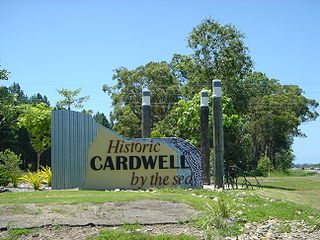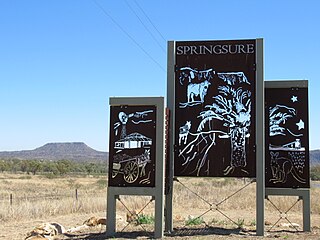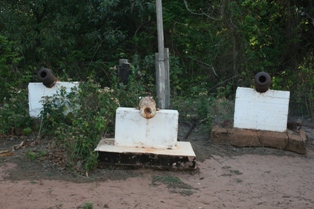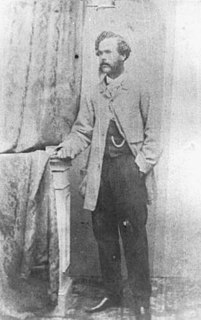
George Poultney Malcolm Murray or simply G.P.M. Murray (13 October 1837 - 3 July 1910) was a senior officer in both the paramilitary Native Police and civilian Queensland Police Force.

George Poultney Malcolm Murray or simply G.P.M. Murray (13 October 1837 - 3 July 1910) was a senior officer in both the paramilitary Native Police and civilian Queensland Police Force.
G.P.M. Murray was born on 13 October 1837 at his family's Georgefield estate near Langholm in southern Scotland. His grandfather was Lieutenant Colonel Matthew Murray of the East India Company who married a Malayali woman from Kerala while in India. The offspring of this marriage, including George's father James Murray, were collectively dubbed the "Black Murrays" on account of their darker skin colour. [1] G.P.M. Murray arrived in New South Wales to live with his parents and siblings in the year 1843. George's father was a pastoralist, his family residing at the Warrawang property at Mt Lambie near Bathurst. [2] [3]
In May 1854 he moved into the northern areas of the colony near the town of Maryborough. He assisted his brother-in-law, H. C. Corfield, in forming Stanton Harcourt, a sheep station taken up by Mr. Corfield in the Wide Bay-Burnett district.
G.P.M. Murray was appointed to the Native Police in December 1857 as a 2nd Lieutenant. [4] His older brother, John Murray, had been in this paramilitary force since 1852. George was posted to the Dawson River region to assist in the reprisals following the Hornet Bank massacre where he maintained an effective control without exercising unnecessary severity. [5] In 1860, he was the officer-in-charge of the barracks at Robinson's Creek near Taroom. In 1861 he was transferred to the Rockhampton barracks and became a senior Lieutenant in the force. In October of that year, the Cullin-la-ringo massacre occurred near the Nogoa River and Murray mobilised his section to that region. He arrived with his troops at the police camp at Rainworth on 26 October. His force "shot a large number of aboriginals and recovered firearms and other property which had been stolen from Cullin-la-Ringo". [6]

With the reorganisation of the Queensland Police Service in 1864 under Commissioner David Thompson Seymour, Murray became more involved in the local administration of the Native Police rather than the more brutal field work. After Lieutenant Brown of the Native Police had assisted in the capture of the famous bushranger, Frank Gardiner, to the north of Rockhampton, Murray was selected as a magistrate in Gardiner's initial trial. [7] In 1865, Murray was publicly condemned by social identity Gideon Lang for his sanctioning of a sequence of massacres of Aboriginal people conducted by sub-Inspector Otto Paschen and his troopers in the Expedition Range. These "dispersals" were in response to the killing of Native Police officer Cecil Hill by Aboriginals near Duaringa. [8]
In spite of these accusations, Murray was promoted in 1866 to Chief Inspector of the Police for the Northern Districts of Queensland, responsible for both civilian and Native Police forces in these regions. The following year, Murray headed an investigation into complaints against sub-Inspector Myrtil Aubin of the Native Police for the killing of eight Aboriginals in the township of Morinish. Murray controversially concluded that it was clearly the duty of Aubin and his troopers to kill these people (which included old men and children [9] ) and "it is very much to be regretted that they did not do so quietly". [10]
In 1866, Murray was posted to Springsure and retained his title of Chief Inspector until 1872.
In 1872, G.P.M. Murray became Police Magistrate and Gold Warden for Clermont and in 1877, Murray became Police Magistrate in Warwick and in 1882 transferred to Toowoomba. After a brief period in Cooktown, he relocated to Brisbane where he became senior state magistrate in 1898. Murray retired from public service in 1904 and moved to the Brisbane suburb of Wilston where he died in 1910. [11] Murray Street in Wilston is named after him. [12]

Cardwell is a tropical coastal town and locality in the Cassowary Coast Region in Far North Queensland, Australia. In the 2016 census, Cardwell had a population of 1,309 people. The Bruce Highway National Highway 1 and the North Coast railway line are the dominant transport routes; connecting with the Queensland provincial cities of Cairns and Townsville. Cardwell suffered significant damage from Cyclone Yasi, a category 5 cyclone, in February 2011.

Springsure is a town and a locality in the Central Highlands Region, Queensland, Australia. It is 66 kilometres (41 mi) south of Emerald on the Gregory Highway. It is the southern terminus of the Gregory Highway and the northern terminus of the Dawson Highway. It is 765 kilometres (475 mi) northwest of Brisbane. In the 2016 census, Springsure had a population of 1,103 people.

Mount Larcom is the name of a mountain, a rural town and locality in the Gladstone Region, Queensland, Australia. In the 2016 census the locality of Mount Larcom had a population of 361 people.

Frederick Walker public servant, property manager, Commandant of the Native Police, squatter and Australian explorer.

Somerset is a coastal locality split between the Shire of Torres and the Northern Peninsula Area Region, Queensland, Australia. In the 2016 census, Somerset had a population of 0 people.

Francis Lascelles (Frank) Jardine was a Scottish-Australian pioneer who was at the forefront of British colonisation and Aboriginal dispossession in the Cape York Peninsula and Torres Strait regions of Far North Queensland.

The Cullin-la-ringo massacre, known historically as the Wills tragedy, occurred north of modern-day Springsure in Central Queensland on 17 October 1861. It remains the largest massacre of white settlers by Aboriginals in Australian history, and a pivotal moment in the frontier wars in Queensland.

Australian native police units, consisting of Aboriginal troopers under the command usually of a single white officer, existed in various forms in all Australian mainland colonies during the nineteenth and, in some cases, into the twentieth centuries. The Native Police were utilised as a cost-effective and paramilitary instrument in the expansion and protection of the Australian frontier. Mounted Aboriginal troopers of the Native Police, armed with rifles, carbines and swords, escorted surveying groups, pastoralists and prospectors into frontier areas. They would usually then establish base camps and patrol these areas to enforce warrants, conduct punitive missions against resisting local Aboriginal groups, and fulfil various other duties.
The Hornet Bank massacre involves the killing of eleven British colonists and one Aboriginal station-hand, by a group of Iman Aboriginal Australians. The massacre occurred at about one or two o'clock in the morning of 27 October 1857 at Hornet Bank station on the upper Dawson River near Eurombah in central Queensland, Australia. It has been moderately estimated that 150 Aborigines succumbed in subsequent punitive missions conducted by Native Police, private settler militias, and by William Fraser in or around Eurombah district. Indiscriminate shootings of "over 300" Aboriginal men, women, and children, however, were reportedly conducted by private punitive expedition some 400 kilometres eastward at various stations in the Wide Bay district alone. The result was the believed extermination of the entire Iman tribe and language group by 1858; this claim was disputed, however, and descendants of this group have recently been recognised by the High Court of Australia to be the original custodians of the land surrounding the town of Taroom.

The Colony of Queensland was a colony of the British Empire from 1859 to 1901, when it became a State in the federal Commonwealth of Australia on 1 January 1901. At its greatest extent, the colony included the present-day State of Queensland, the Territory of Papua and the Coral Sea Islands Territory.

Richard Bingham Sheridan, was a Queensland public servant, liberal-oriented Member of the Legislative Assembly of Queensland and government minister.

George Augustus Frederick Elphinstone Dalrymple was a colonist, explorer, public servant and politician, member of the Legislative Assembly of Queensland.

Alexander Douglas Douglas was a naval officer, an inspector in the Native Police and a chief inspector of police in Queensland.
Wentworth D'Arcy Uhr was an officer in the paramilitary Native Police in the British colony of Queensland. After being demoted for poor conduct, he resigned from this force and became a drover, leading the first herds of cattle into the region now known as the Northern Territory. He later became, amongst other vocations, a gold prospector, butcher and hotelier. Throughout his life, Uhr actively engaged in multiple incidents of frontier violence including several massacres of Aboriginals. He was also the subject of numerous court cases defending charges which ranged from murder and assault to race-fixing and fraud. In later life he moved to Western Australia and became a business partner with Charles Kidman, brother of the famous pastoralist, Sidney Kidman.

John O'Connell Bligh was a Native Police officer in the British colonies of New South Wales and Queensland. He achieved the rank of Commandant of this colonial paramilitary force from 1861 to 1864. Bligh is probably best known for an incident in Maryborough, where he shot a number of Aboriginal Australians along the main street and into the adjoining Mary River. After retiring from the Native Police, Bligh became a police magistrate in the towns of Gayndah and Gympie.

Edric Norfolk Vaux Morisset was a high-ranking officer in both the paramilitary and civilian police forces of the New South Wales and Queensland colonies of the British Empire. He was Commandant of the paramilitary Native Police from 1857 to 1861 and concurrently became the first Inspector General of Police in Queensland in 1860. Morisset afterwards was appointed Superintendent of Police at Bathurst and then later on at Maitland. From 1883 until his death in 1887, Morisset was Superintendent of the Southern Districts and Deputy Inspector General of Police in New South Wales.
Walter David Taylor Powell was an English mariner and paramilitary Native Police officer in the British colonies of New South Wales and Queensland. He played a significant part in the practical implementation of British colonial rule in the coastal areas of Queensland. His role as an officer in the Native Police was central in a number of important moments in colonial Queensland history including that of the brutal crushing of localised Aboriginal resistance after the Hornet Bank massacre, the foundation of Rockhampton and the creation of the Bowen settlement. He also had major contributions in the founding of Cardwell, the coastal and South Seas trade, and the British colonisation of the Torres Strait.

John Murray was an officer in the Native Police in the British colonies of New South Wales and Queensland. He was an integral part of this paramilitary force for nearly twenty years, implementing British colonisation in south-eastern, central and northern Queensland. He also had an important role in recruiting troopers for the Native Police from the Riverina District in New South Wales.

Robert Arthur Johnstone was an officer in the Native Police paramilitary force which operated in the British imperial colony of Queensland. He was stationed at various locations in central and northern Queensland between 1867 and 1880 conducting regular punitive expeditions against clans of Indigenous Australians who resisted British invasion. He also participated in several surveying expeditions in Far North Queensland, including those under the leadership of George Elphinstone Dalrymple, providing well-armed protection for the British explorers. As a result of being at the frontier of British colonial expansion in this region of Australia, a number of geographical and zoological entities are named after him, such as the Johnstone River and the freshwater crocodile. After resigning from the Native Police in 1880, Johnstone was a police magistrate in various locations around Queensland before he retired from government service in 1891. In his years of duty for the Native Police, Johnstone led many punitive expeditions and "dispersals". Whilst the activities of the Native Police were consistent with both Government policy and popular expectation, thousands of Aboriginal people were killed or displaced from their traditional lands by the Native Police.

John Bye Durnford Marlow was an officer in the paramilitary Native Police force in the British colony of Queensland. He served in this corps for fourteen years and was stationed at frontier sites such as the Maranoa Region, Port Denison and on the Burdekin River. Marlow, by leading armed escorts of troopers, was also intrinsically involved in the expeditions which led to the establishment of the towns of Cardwell and Townsville.